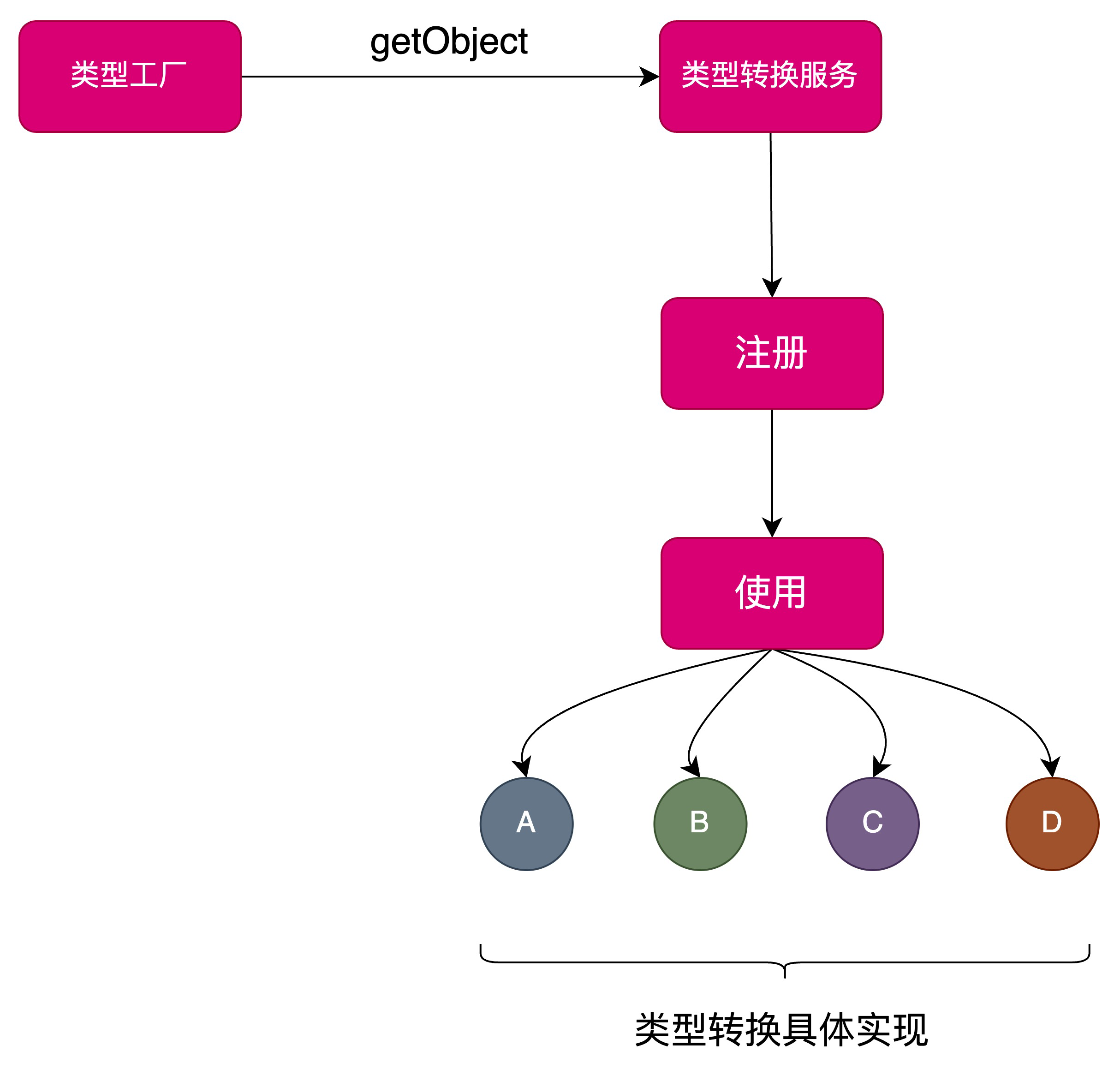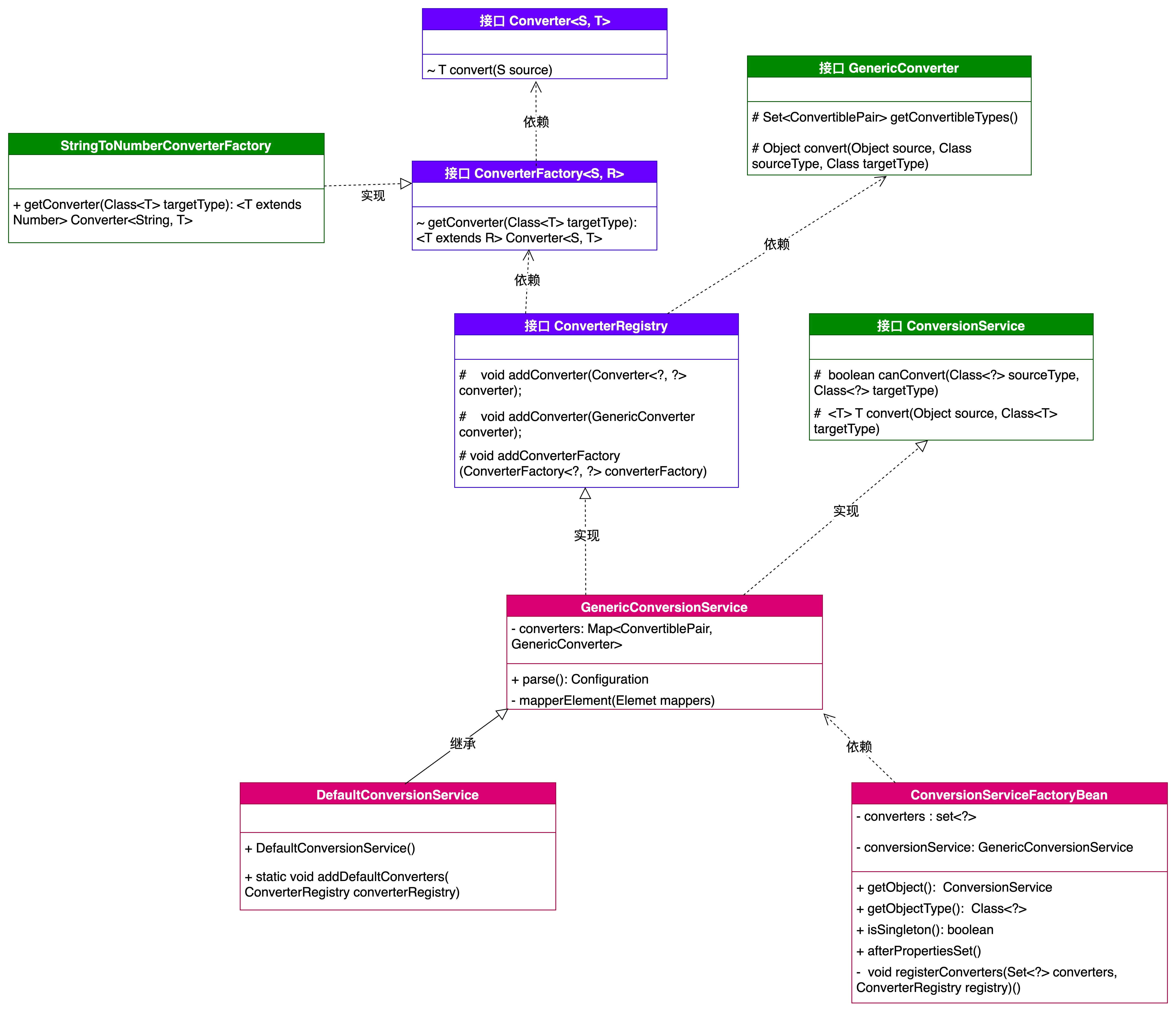《手写Spring渐进式源码实践》实践笔记(第十七章 数据类型转换)
文章目录
- 第十七章 数据类型转换工厂设计实现
- 背景
- 技术背景
- Spring数据转换实现方式
- 类型转换器(Converter)接口设计实现
- 业务背景
- 目标
- 设计
- 实现
- 代码结构
- 类图
- 实现步骤
- 测试
- 事先准备
- 属性配置文件
- 转换器工厂Bean
- 测试用例
- 测试结果:
- 总结
第十七章 数据类型转换工厂设计实现
背景
技术背景
Spring数据转换实现方式
Spring提供了多种机制来实现数据转换,以下是一些主要的方式:
-
类型转换器(Converter)接口: Spring提供了
Converter<S, T>接口,允许开发者自定义转换逻辑。通过实现这个接口,你可以定义如何将源类型S转换为目标类型T。例如:@Component public class StringToIntegerConverter implements Converter<String, Integer> { @Override public Integer convert(String source) { return Integer.valueOf(source); } }然后,你可以在配置中注册这个转换器,Spring会自动在需要的时候使用它。
-
属性编辑器(PropertyEditor):
PropertyEditor是Java的一个老机制,Spring也支持它。通过实现PropertyEditor接口,你可以定义如何将字符串转换为其他类型。不过,从Spring 5开始,推荐使用Converter接口,因为PropertyEditor将在未来版本中被弃用。 -
格式化程序(Formatter):
Formatter是Java的一个接口,用于格式化和解析对象。Spring通过FormattingConversionService支持Formatter,可以在Spring MVC中使用它来格式化和解析数据。 -
自动应用的转换器(Global Converters): 在Spring MVC中,可以通过实现
WebMvcConfigurer接口的addFormatters方法来添加全局的转换器,这些转换器会对所有的控制器方法参数和返回值进行转换。java
@Override public void addFormatters(FormatterRegistry registry) { registry.addConverter(new StringToIntegerConverter()); } -
局部转换器(Local Converters): 除了全局转换器,你还可以在方法级别使用
@InitBinder注解来添加局部转换器,这些转换器只对特定的控制器或请求参数有效。 -
Spring Expression Language(SpEL): SpEL也支持类型转换,当你在表达式中使用不同类型的值时,SpEL会尝试进行适当的类型转换。
-
Java标准转换: Spring还会利用Java的自动装箱和拆箱特性,以及
Number类的intValue、longValue等方法来进行基本的类型转换。 -
自定义转换服务: 你可以通过编程方式创建
ConversionService的实例,并注册自定义的转换器,然后在你的应用程序中使用这个服务来进行类型转换。
类型转换器(Converter)接口设计实现
Spring 中的类型转换器(Converter)接口的底层生效思路主要涉及以下几个方面:
-
接口定义:
Converter<S, T>是一个函数式接口,用于将类型S的对象转换为类型T的对象。这个接口定义了一个convert方法,该方法接受一个类型为S的源对象,并返回一个类型为T的目标对象。 -
转换器注册: 转换器可以通过实现
Converter接口并注册到ConversionService中来生效。ConversionService是 Spring 中的一个核心接口,负责管理所有的转换器,并根据需要调用适当的转换器来执行类型转换。 -
条件转换器:
ConditionalConverter接口允许在转换过程中添加条件判断,以决定是否使用特定的转换器。这提供了更细粒度的控制,允许在运行时根据具体情况选择是否应用某个转换器。 -
转换器工厂:
ConverterFactory<S, R>接口用于创建一系列相关转换器,它允许从类型S转换到类型R的子类型。这种设计模式支持了范围转换,即从一种类型到多种可能的子类型的转换。 -
泛型转换器:
GenericConverter接口提供了在两个或多个类型之间进行转换的能力,它是最灵活但也是最为复杂的转换器SPI接口。GenericConverter可以处理更复杂的转换场景,比如集合到集合的转换。 -
默认转换服务:
DefaultConversionService是GenericConversionService的一个实现,它提供了一个默认的转换服务,包含了许多内置的转换器,覆盖了大多数常用的类型转换场景。如果需要自定义转换逻辑,可以向DefaultConversionService添加自定义的转换器。 -
转换器查找和缓存: Spring 会根据源类型和目标类型查找合适的转换器。如果找到了匹配的转换器,Spring 会将其缓存起来以提高性能。如果缓存中没有找到匹配的转换器,Spring 会尝试查找并添加新的转换器,然后再次尝试转换。
-
转换器的链式调用:
Converter接口中的andThen方法支持转换器的链式调用,允许将多个转换步骤串联起来,先应用一个转换器,然后将结果传递给下一个转换器。
业务背景
- 其实实现到本章节,关于IOC、AOP在日常使用和面试中高频出现的技术点都该涵盖了。那么为了补全整个框架内容的结构,方便大家后续在阅读 Spring 时不至于对类型转换的知识体系陌生,这里添加数据类型转换中关于类型转换器的实现。
- 类型转换也叫做数据转换,比如从String到Integer、从String到Date、从Double到Long等等,但这些操作不能在已经使用框架的情况下还需要手动处理,所以我们要把这样的功能扩展到Spring框架中。
目标
基于当前实现的 Spring 框架,扩展类型转换功能,并熟悉spring组件服务的开发思路。
设计
如果我们来把只是看上去一个简单的类型转换操作抽象成框架,那么它就需要一个标准的接口,谁实现这个接口就具备类型转换的具体实现,提供类型转换的能力。
那么在有了这样接口后,还需要类型转换服务的注册、工厂等内容,才可以把类型转换抽象成一个组件服务。整体设计结构如下图:

-
首先从工厂出发我们需要实现一个 ConversionServiceFactoryBean 来对类型转换服务进行操作。
-
而实现类型转换的服务,需要定义 Converter 转换类型、ConverterRegistry 注册类型转换功能,另外转换类型的操作较多,所以这里也会需要定义一个类型转换工厂 ConverterFactory 各个具体的转换操作来实现这个工厂接口。
实现
代码结构

源码实现:https://github.com/swg209/spring-study/tree/main/step17-type-converter-factory
类图

实现步骤
-
类型转换接口
a. Converter 转换器,提供类型转换方法。
public interface Converter<S, T> { /** * 将source从 S类型转换为T类型. */ T convert(S source); }b. ConverterFactory 转换工厂,用于获取转换器。
public interface ConverterFactory<S, R> { /** * 获取转换器,将source从S类型转换为T类型,其中T也是R的实例。 * * @param targetType * @param <T> * @return */ <T extends R> Converter<S, T> getConverter(Class<T> targetType); }c. ConverterRegistry 转换注册中心,用于服务注册转换器、转换工厂。
public interface ConverterRegistry { void addConverter(Converter<?, ?> converter); void addConverter(GenericConverter converter); void addConverterFactory(ConverterFactory<?, ?> converterFactory); }d. ConverterService 转换服务,提供 判断类型能否转换以及转换方法。
public interface ConversionService { /** * 是否可以转换. * * @param sourceType * @param targetType * @return */ boolean canConvert(Class<?> sourceType, Class<?> targetType); /** * 转换. * * @param source * @param targetType * @param <T> * @return */ <T> T convert(Object source, Class<T> targetType); }e. GenericConverter 通用转换器,门面接口,并有一个内部类 ConvertiblePair,包装 源类型 与 目标类型。
public interface GenericConverter { /** * Return the source and target types that this converter can convert between. * 返回此转换器可以在其之间转换的源和目标类型. */ Set<ConvertiblePair> getConvertibleTypes(); /** * Convert the source object to the targetType described by the {@code TypeDescriptor}. * 将源对象转换为由{@code TypeDescriptor}描述的targetType. * * @param source * @param sourceType * @param targetType * @return */ Object convert(Object source, Class sourceType, Class targetType); /** * Holder for a source-to-target class pair. * 源类型到目标类型的持有者. */ final class ConvertiblePair { private final Class<?> sourceType; private final Class<?> targetType; public ConvertiblePair(Class<?> sourceType, Class<?> targetType) { Assert.notNull(sourceType, "source type must not be null"); Assert.notNull(targetType, "target type must not be null"); this.sourceType = sourceType; this.targetType = targetType; } public Class<?> getSourceType() { return this.sourceType; } public Class<?> getTargetType() { return this.targetType; } @Override public boolean equals(Object obj) { if (this == obj) { return true; } if (obj == null || obj.getClass() != ConvertiblePair.class) { return false; } ConvertiblePair other = (ConvertiblePair) obj; return this.sourceType.equals(other.sourceType) && this.targetType.equals(other.targetType); } @Override public int hashCode() { return this.sourceType.hashCode() * 31 + this.targetType.hashCode(); } } } -
类型转换服务
a. GenericConversionService , 实现 ConversionService ,ConverterRegistry, 并添加 根据 转换器或工厂 生成对应类型的 ConvertiblePair 以及 遍历源和目标一系列超类的所有组合,获取转换器 的方法辅助,设有 内部类 ConverterFactoryAdapter ,ConverterAdapter 实现 GenericConverter,用于 适配 通用转换器,方便注册及调用。
public class GenericConversionService implements ConversionService, ConverterRegistry {
// 转换器映射表.
private Map<ConvertiblePair, GenericConverter> converters = new HashMap<>();
@Override
public boolean canConvert(Class<?> sourceType, Class<?> targetType) {
GenericConverter converter = getConvert(sourceType, targetType);
return converter != null;
}
@Override
public <T> T convert(Object source, Class<T> targetType) {
Class<?> sourceType = source.getClass();
GenericConverter converter = getConvert(sourceType, targetType);
return (T) converter.convert(source, sourceType, targetType);
}
@Override
public void addConverter(Converter<?, ?> converter) {
GenericConverter.ConvertiblePair typeInfo = getRequiredTypeInfo(converter);
ConverterAdapter converterAdapter = new ConverterAdapter(typeInfo, converter);
for (GenericConverter.ConvertiblePair convertibleType : converterAdapter.getConvertibleTypes()) {
converters.put(convertibleType, converterAdapter);
}
}
@Override
public void addConverter(GenericConverter converter) {
// 遍历转换器支持的类型,将其添加到转换器映射表中.
for (GenericConverter.ConvertiblePair convertibleType : converter.getConvertibleTypes()) {
converters.put(convertibleType, converter);
}
}
@Override
public void addConverterFactory(ConverterFactory<?, ?> converterFactory) {
ConvertiblePair typeInfo = getRequiredTypeInfo(converterFactory);
ConverterFactoryAdapter converterFactoryAdapter = new ConverterFactoryAdapter(typeInfo, converterFactory);
for (ConvertiblePair convertibleType : converterFactoryAdapter.getConvertibleTypes()) {
converters.put(convertibleType, converterFactoryAdapter);
}
}
private GenericConverter getConvert(Class<?> sourceType, Class<?> targetType) {
List<Class<?>> sourceCandidates = getClassHierarchy(sourceType);
List<Class<?>> targetCandidates = getClassHierarchy(targetType);
for (Class<?> sourceCandidate : sourceCandidates) {
for (Class<?> targetCandidate : targetCandidates) {
ConvertiblePair convertiblePair = new ConvertiblePair(sourceCandidate, targetCandidate);
GenericConverter converter = converters.get(convertiblePair);
if (converter != null) {
return converter;
}
}
}
return null;
}
private List<Class<?>> getClassHierarchy(Class<?> clazz) {
List<Class<?>> hierarchy = new ArrayList<>();
while (clazz != null) {
hierarchy.add(clazz);
clazz = clazz.getSuperclass();
}
return hierarchy;
}
//因为要同时兼容 Converter、ConverterFactory,所以这里传参为Object.
private ConvertiblePair getRequiredTypeInfo(Object object) {
Type[] types = object.getClass().getGenericInterfaces();
ParameterizedType parameterizedType = (ParameterizedType) types[0];
Type[] actualTypeArguments = parameterizedType.getActualTypeArguments();
Class sourceType = (Class) actualTypeArguments[0];
Class targetType = (Class) actualTypeArguments[1];
return new ConvertiblePair(sourceType, targetType);
}
private final class ConverterAdapter implements GenericConverter {
private final ConvertiblePair typeInfo;
private final Converter<Object, Object> converter;
public ConverterAdapter(ConvertiblePair typeInfo, Converter<?, ?> converter) {
this.typeInfo = typeInfo;
this.converter = (Converter<Object, Object>) converter;
}
@Override
public Set<ConvertiblePair> getConvertibleTypes() {
return Collections.singleton(typeInfo);
}
@Override
public Object convert(Object source, Class sourceType, Class targetType) {
return converter.convert(source);
}
}
private final class ConverterFactoryAdapter implements GenericConverter {
private final ConvertiblePair typeInfo;
private final ConverterFactory<Object, Object> converterFactory;
public ConverterFactoryAdapter(ConvertiblePair typeInfo, ConverterFactory<?, ?> converterFactory) {
this.typeInfo = typeInfo;
this.converterFactory = (ConverterFactory<Object, Object>) converterFactory;
}
@Override
public Set<ConvertiblePair> getConvertibleTypes() {
return Collections.singleton(typeInfo);
}
@Override
public Object convert(Object source, Class sourceType, Class targetType) {
return converterFactory.getConverter(targetType).convert(source);
}
}
}
b. DefaultConversionService ,继承 GenericConversionService ,通过构造函数注册 内置的 类型转换器或工厂, 并对外作为一个 注册中心使用。
public class DefaultConversionService extends GenericConversionService {
public DefaultConversionService() {
addDefaultConverters(this);
}
public static void addDefaultConverters(ConverterRegistry converterRegistry) {
// 添加各类类型转换工厂.
converterRegistry.addConverterFactory(new StringToNumberConverterFactory());
}
}
-
融入 Bean 的生命周期
a. 类型转换工厂 ConversionServiceFactoryBean,实现 FactoryBean, InitializingBean,这样 在其初始化时就可以 注册类型转换器、工厂。public class ConversionServiceFactoryBean implements FactoryBean<ConversionService>, InitializingBean { @Nullable private Set<?> converters; @Nullable private GenericConversionService conversionService; @Override public ConversionService getObject() throws Exception { return conversionService; } @Override public Class<?> getObjectType() { return conversionService.getClass(); } @Override public boolean isSingleton() { return true; } @Override public void afterPropertiesSet() throws BeansException { this.conversionService = new DefaultConversionService(); registerConverters(converters, conversionService); } private void registerConverters(Set<?> converters, ConverterRegistry registry) { if (converters != null) { for (Object converter : converters) { if (converter instanceof GenericConverter) { registry.addConverter((GenericConverter) converter); } else if (converter instanceof Converter<?, ?>) { registry.addConverter((Converter<?, ?>) converter); } else if (converter instanceof ConverterFactory<?, ?>) { registry.addConverterFactory((ConverterFactory<?, ?>) converter); } else { throw new IllegalArgumentException("Each converter object must implement one of the " + "Converter, ConverterFactory, or GenericConverter interfaces" + "Unsupported converter type: " + converter.getClass()); } } } } public void setConverters(Set<?> converters) { this.converters = converters; } }
b. 通过 ConfigurableBeanFactory 添加 设置、获取类型转换服务方法,由 AbstractBeanFactory 实现,使得 在刷新容器 实例化单例对象前,可以优先获取到 ConversionServiceFactoryBean ,并设置 beanfactory 的 类型转换服务;并在 AbstractAutowireCapableBeanFactory 的 createBean 属性填充前 增加 类型转换的操作。
测试
事先准备
多类型属性的类 Husband
Husband
public class Husband {
private String wifeName;
private LocalDate marriageDate;
public String getWifeName() {
return wifeName;
}
public void setWifeName(String wifeName) {
this.wifeName = wifeName;
}
public LocalDate getMarriageDate() {
return marriageDate;
}
public void setMarriageDate(LocalDate marriageDate) {
this.marriageDate = marriageDate;
}
@Override
public String toString() {
return "Husband{" +
"wifeName='" + wifeName + '\'' +
", marriageDate=" + marriageDate +
'}';
}
}
属性配置文件
spring.xml
- 配置husband,类型转换服务工厂Bean, 类型转换服务
<?xml version="1.0" encoding="UTF-8"?>
<beans xmlns:xsi="http://www.w3.org/2001/XMLSchema-instance"
xmlns="http://www.springframework.org/schema/beans"
xsi:schemaLocation="http://www.springframework.org/schema/beans
http://www.springframework.org/schema/beans/spring-beans.xsd">
<bean id="husband" class="cn.suwg.springframework.test.bean.Husband">
<property name="wifeName" value="老老"/>
<property name="marriageDate" value="2022-04-14"/>
</bean>
<bean id="conversionService" class="cn.suwg.springframework.context.support.ConversionServiceFactoryBean">
<property name="converters" ref="converters"/>
</bean>
<bean id="converters" class="cn.suwg.springframework.test.converter.ConvertersFactoryBean"/>
</beans>
转换器工厂Bean
ConvertersFactoryBean
public class ConvertersFactoryBean implements FactoryBean<Set<?>> {
@Override
public Set<?> getObject() throws Exception {
HashSet<Object> converters = new HashSet<>();
StringToLocalDateConverter stringToLocalDateConverter = new StringToLocalDateConverter("yyyy-MM-dd");
converters.add(stringToLocalDateConverter);
return converters;
}
@Override
public Class<?> getObjectType() {
return null;
}
@Override
public boolean isSingleton() {
return true;
}
}
StringToIntegerConverter
public class StringToIntegerConverter implements Converter<String, Integer> {
@Override
public Integer convert(String source) {
return Integer.valueOf(source);
}
}
StringToLocalDateConverter
public class StringToLocalDateConverter implements Converter<String, LocalDate> {
private final DateTimeFormatter DATE_TIME_FORMATTER;
public StringToLocalDateConverter(String pattern) {
DATE_TIME_FORMATTER = DateTimeFormatter.ofPattern(pattern);
}
@Override
public LocalDate convert(String source) {
return LocalDate.parse(source, DATE_TIME_FORMATTER);
}
}
测试用例
public class ApiTest {
@Test
public void testConvert() {
ClassPathXmlApplicationContext applicationContext = new ClassPathXmlApplicationContext("classpath:spring.xml");
Husband husband = applicationContext.getBean("husband", Husband.class);
System.out.println("测试结果: " + husband);
}
//返回转换好的日期. 年-月-日
@Test
public void testStringToLocalDateConverter() {
StringToLocalDateConverter converter = new StringToLocalDateConverter("yyyy-MM-dd hh:mm:ss");
LocalDate convert = converter.convert("2024-11-07 10:00:11");
LocalDate expect = LocalDate.of(2024, 11, 7);
Assert.assertEquals(expect, convert);
System.out.println(convert);
}
// 测试字符串转换为整数.
@Test
public void testStringToIntegerConverter() {
StringToIntegerConverter converter = new StringToIntegerConverter();
Integer convert = converter.convert("12345");
Assert.assertEquals(Integer.valueOf(12345), convert);
System.out.println(convert);
}
}
测试结果:

- 从测试结果可以看到,字符串转日期转换器功能正常。

- 从测试结果可以看到,字符串转数字转换器功能正常。

- 从测试结果可以看到,对象属性值可以正常输出到日志。这个测试内容还是比较简单的,可以自行验证结果,虽然最终的结果看上去比较简单,但整个框架结构实现设计还是蛮复杂的,把这么一个转换操作抽象为接口适配、工厂模型等方式,还是很值得借鉴的。
总结
- 本章节实现的类型转换操作如果只是功能性的开发,就像你自己承接的需求那样,可能只是简单的if判断就搞定了,但放在一个成熟的框架要中要考虑的是可复用性、可扩展性,所以会看到接口的定义、工厂的使用等等设计模式在这里体现。
- 恭喜你,能够坚持学习到这一章节。如果你在学习过程中,每一章节都是通过阅读文章、编写代码、调试错误以及理解设计来完成的,那么一定会在这个过程中获得很多宝贵的经验和知识。以后再次阅读Spring源码时,就不会觉得那么困难了。
参考书籍:《手写Spring渐进式源码实践》
书籍源代码:https://github.com/fuzhengwei/small-spring
